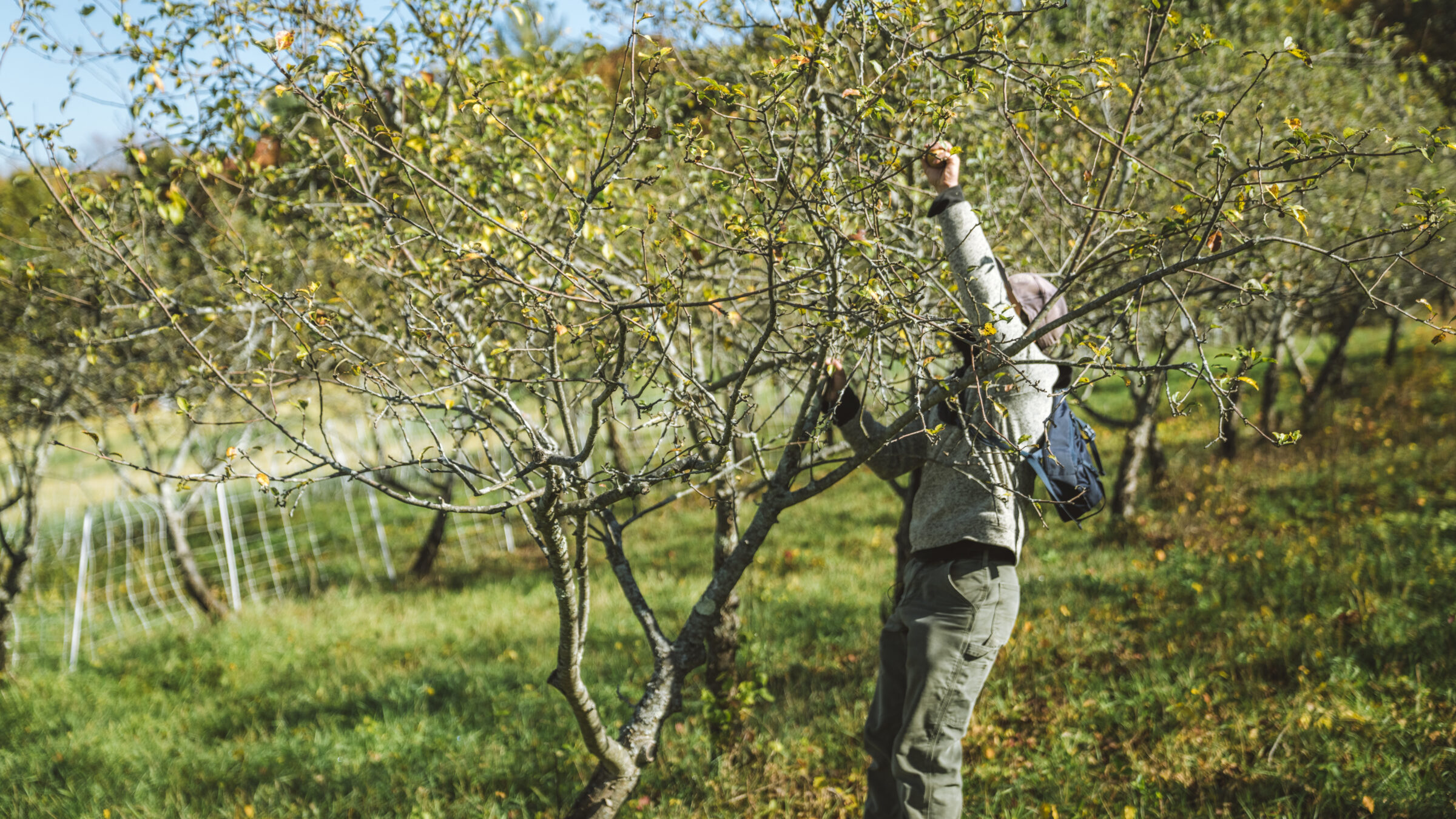
10. Management and Seasonal Care
While growing perennials requires a lot less intensive care than most annual crops, you can’t simply plant a tree and walk away! Tree care can be delivered on a broad spectrum from coddling each plant with hours of attention to complete abandonment. The level of care you choose to provide will depend on two factors: your goals for the planting and the amount of time you have available.
S.T.U.N.: The “Sheer Total Utter Neglect” method, a term coined by Mark Shepard (Restoration Agriculture Development), works well if you have an abundance of free or very inexpensive planting stock (such as seeds or seedings you raised yourself) and are not attached to a specific planting pattern or outcome. If your site is extremely large or has limited accessibility, you may simply allow nature to decide who lives and dies and trust that the superior specimen will thrive without additional care. This method can also be effective for “re-wilding” areas with species that will primarily feed and provide habitat for livestock or wildlife.
Pampering: Conversely, pampering your trees may increase their overall survival rate but unintentionally leave them vulnerable to risks outside your control. For example, trees that are individually staked and supported with bungees and ties may not develop strong enough root systems to withstand sudden storm squalls or extreme weather events. Adding too much compost can throw off the balance of nutrients in the soil, prevent adequate drainage, or even cause the tree to grow too quickly. Most of all, the higher labor involved will likely not yield measurable results for the outcome of your planting.
A good middle path is to reduce (though not eliminate) the stress your trees are exposed to in the first 2-3 years after planting to best set them up for a long, healthy, productive life. Trees sometimes die; no one method or care regiment can prevent some mortality in every planting. Larger plantings can handle the loss of a few shrubs or trees without impacting overall productivity; however, planting two trees and losing one may result in no production at all, as in the case of non-self-pollinating species such as apples and chestnuts.
The following best practices will likely result in low levels of mortality without demanding too much of your time and attention:
- Start with healthy, high-quality nursery stock
- Manage your land holistically instead of trying to create isolated “pockets” of fertility
- Protect your trees from herbaceous and root-devouring predators
- Keep trees mulched and prevent the overgrowth of weeds
- Visit your trees! “The best fertilizer is the farmer’s footprint.” Even if you do not provide any direct care when you’re out in the field, your regular observations will keep you informed about the overall health and well-being of your planting before problems become unmanageable and help you assess and prioritize your seasonal tree care tasks.
Predators
The primary predators of trees during establishment and beyond are deer, rabbits, and voles. Other critters might be a problem in some areas. Herbivore pressure varies immensely by location, year, and other crops or livestock tended. Observing the particulars of your location is critical, including how wildlife are already interacting with your land prior to planting.
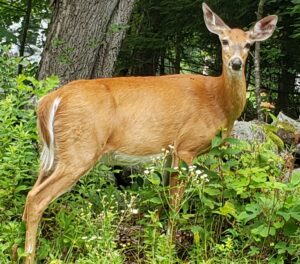
Deer
Deer browse pressure on trees can be mild to intense. Deer can decimate trees while young, reducing the chance of growth ever getting above browse height. Buck antler rubbing in the fall and winter can injure or even snap the trunks of young trees in half. Reducing access to trees with physical barriers, e.g., fencing, cages, or tree tubes, is the primary approach to deer protection. Other methods like hanging soap, predator scent or feces, water jets, or noise guns might also be effective in some circumstances.
Rabbits
Rabbits are particularly fond of chewing on bark and cambium in the late winter months, which can girdle and even destroy trees of any age. Particularly when the snow pack is deep, they will chew just above the snow line if trunks are exposed or shrub growth is within reach. The best protection is generally a short welded wire or hardware cloth cage that wraps around the bottom 12-18” of a tree where rabbit pressures are high. However, these wire cages must be removed during the primary growing season or checked seasonally to ensure tree trunk growth has not swelled into the metal cage.
Meadow Voles
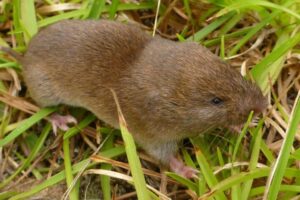
Voles can wipe out large numbers of young trees. They live at the ground surface or just below, tunneling and surfacing in dense warrens, particularly in the winter when other food is scarce. Densities can become huge and fluctuate wildly, in some places reportedly reaching 800 per acre. Voles can be particularly difficult to guard against as they will burrow just beneath the surface to completely devour the tender roots of a young tree. Some growers will install tree tubes by burying them about 2 inches below the soil surface to deter voles. According to Austin Unruh (Trees For Graziers), a vinyl guard at the base of each tree, along with granulated castor oil, will mostly keep the rodents away. Also, efforts to encourage natural vole predators, including felines, snakes, and birds of prey, may be better for your bottom line and the surrounding ecosystem.
Tree Protection
Is a $10 tree also worth $10 of protection? In most cases, yes! While protecting your trees can add additional expense to a project, not protecting your trees is a gamble that could be very discouraging to the success of your project. The key is to know what type of protection will be most effective for the particulars of your site.
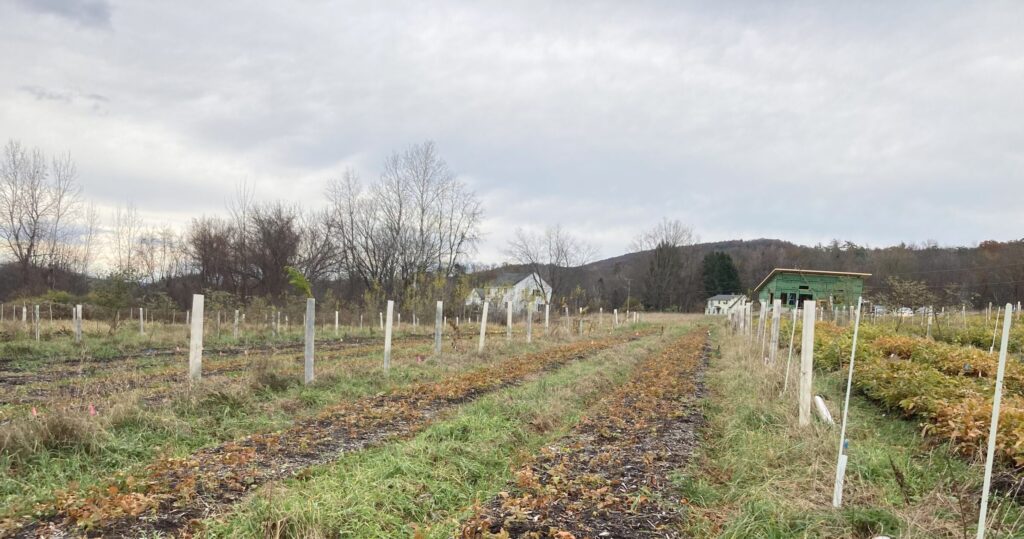
Tree Tubes
The best commercially available option for most tree crop producers is 5′ or 6’ tall tree tubes. These UV-resistant plastic tubes create a mini-greenhouse around each young tree, encouraging upward growth habits while protecting from most herbivores (not including rutting bucks) during the first 3-4 years of establishment until the tree is at least 2” in diameter at breast height. In grazing operations, some growers will wrap the tree tubes in barbed wire to deter cattle from rubbing against them. Still others find that if they keep their animals moving relatively quickly through different areas, rubbing is not usually a problem.
The Plantra SunFlex® Tree Tube costs around $9-12 per tube but offers high durability and has proven to be a practical choice for use primarily in open field and silvopasture systems. In our experience, they can also be removed from established plantings and reused for new plantings for up to 10 years.
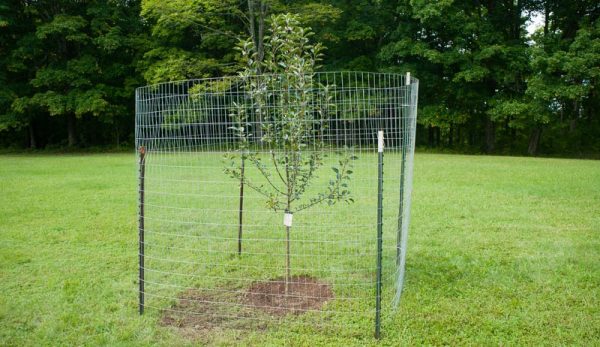
Welded Wire Cage
If you only have a handful of trees to protect, surrounding each tree with a 6’ welded wire cage is an effective way to keep out deer and is much less expensive than installing 10+’ perimeter fencing around an entire field. While deer can jump higher than 6’, they are unlikely to jump into such a small enclosure. This type of fencing is also durable and reusable. However, it can make accessing the tree difficult for mulching, weeding, and watering, and will not protect against rabbits or voles.
Window Screen
If you are protecting small-diameter trees in a nursery setting and don’t want to disturb their root systems over the winter, you can cut short lengths of window screen to wrap around the base of each stem to protect from rabbits or voles who may burrow under the snow to chew cambium and girdle the trees.
Electric Fencing
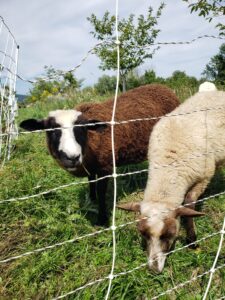
If your goal is to protect individual trees from your own livestock, including pigs, sheep, goats, and cattle, you may need to electrify your fencing to ensure tree survival during the critical establishment years. Those practicing managed or rotational grazing with moveable fencing can use an extra length of 4-strand poly rope to surround newly planted trees along field edges while the animals are grazing in that area.
Pest Deterrents
Farmers and orchardists have long used natural deterrents to ward off smaller critters. A few that may be worth trying are granulated castor oil, blood meal, urine, hair clippings, mint/aromatic herbs, and calcium lime (take care not to burn tree roots by placing too close).
Physical Presence
Arguably, the most effective deterrent is your physical presence on the land. Dogs or other guard livestock (e.g., horses, donkeys, llamas, geese) may also be helpful.
Livestock Fencing
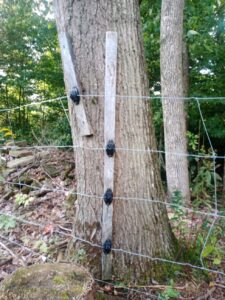
Good electric perimeter fencing is essential for those integrating livestock, and myriad products and systems are available on the market. However, developing and maintaining fencing can also be an enormous sink of time and money, primarily if you work on leased land. One tip from Brett Chedzoy (Angus Glen Farms, NY) is to use existing trees for fence posts, protecting them from damage caused by swallowing fence wires with a simple board.
Another alternative to metal T-posts or 4×4 locust posts is rigid PVC posts from Timeless Fence. Though pricier, they are easier to install in wooded areas, durable, strong, highly visible, and versatile for different types of livestock.
- Greg Judy loves his new silvopasture electric fence posts from Timeless Fence.
- Planning & Building Fences on the Farm – UT Extension.pdf
- fencingandgrounding.pdf
Seasonal Care
While tree care is considerably less intensive than annual cropping systems, it is still essential to keep up with regular seasonal management, especially during the establishment years, to maximize the outputs and benefits of your agroforestry project. Austin Unruh (Trees for Graziers) forewarns growers about “The Dip” he has observed as the initial excitement of a new planting wanes before any measurable impacts can be observed. “Sleep, creep, leap, reap” is another old gardening adage that reminds us of the rewards that come with patience and diligence. Neglecting tree care, particularly in the years when perennials are getting established, can derail your entire project. As the saying goes, “Take care of your trees now, and they will take care of you later.”
Another good piece of advice to remember: “Don’t bite off more than you can chew.” There is a significant difference between caring for a handful of trees and achieving the economies of scale that come with a larger planting and more mechanized management. Mid-sized production agroforestry plantings (perhaps between 1-10 acres) can be deceptively time-consuming, especially during the establishment years.
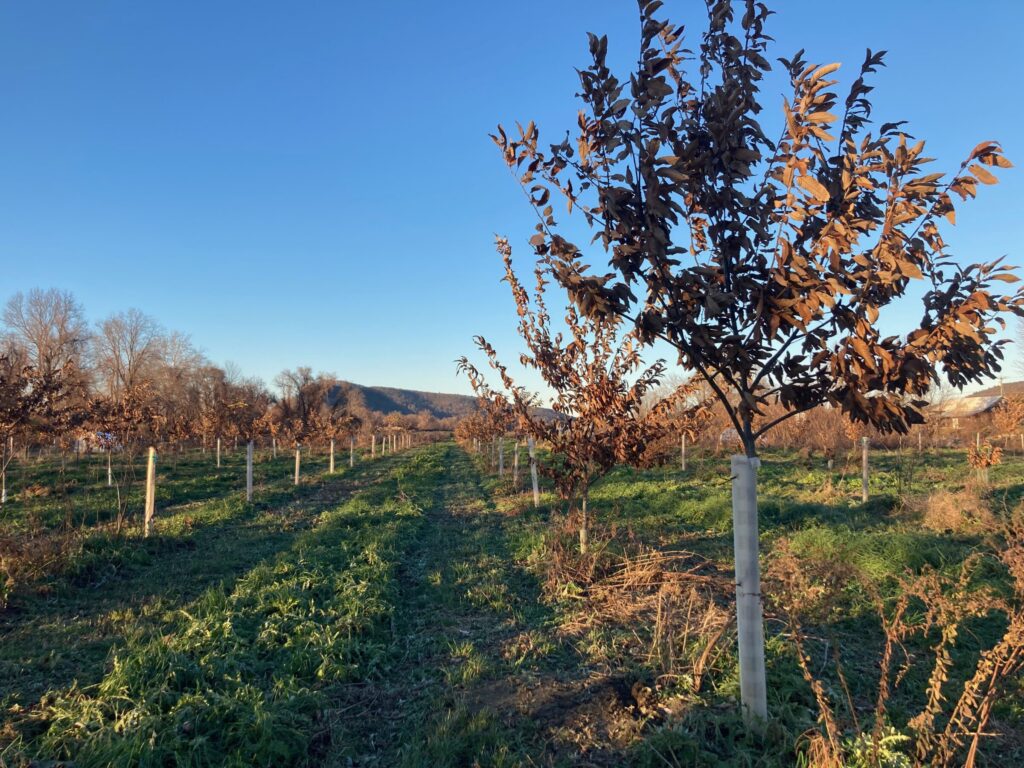
The chart below lists the activities you will typically need to attend to throughout the year to care for your perennial plantings.
| Establishment Years (Years 1-3+) | Mature Years (Years 4-8+) | |
| Spring | Mulching | Mulching |
| Summer | Ensure adequate irrigation Mowing, weed control Pest/predator control | Mowing, weed control Pest/predator control Harvest (fodder, berries, fruit) |
| Fall | Pest/predator control Check tree tubes Assess soil Amend soil | Harvest (nuts, fodder, berries, fruit) Pest/predator control Assess soil Amend soil (if necessary) |
| Winter | Pest/predator control | Pruning, Coppicing, etc. |
Mulch
Providing good quality mulch in a new tree planting and throughout the establishment years will significantly reduce competition from weeds, improve the fungal diversity and health of your soil, and help retain critical moisture during dry spells. The ideal mulch is made from ramial woodchips – the thin branches and twigs of chipped hardwood trees. Woodchips are superior to all other landscape mulch materials in moisture retention, temperature moderation, and weed control. Their variable size and decomposition rate create the ideal environment for diverse soil biology. They are rich in lignin and tannins and are relatively slow to decompose, which supply nutrients to the soil over a more extended period while absorbing and releasing significant amounts of water for plant uptake.
Woodchip mulch can often be acquired at no cost from tree trimming and/or electric companies. If the chips also contain softwood, mix with lime to help correct for low acidity. If you cannot obtain woodchips, bark mulch is a decent alternative and is relatively cheap to purchase from the sawmill or your local landscape supply.
The correct amount of mulch to apply is approximately 2-3 inches in a wide circle around each tree, with slightly less (1-2 inches) around the base of the tree. This will provide the best weed control. You can lay cardboard or underlayment paper underneath the mulch layer for enhanced weed protection. Weeds typically take a year or more to grow through this double layer. Generally, a single application of mulch at planting and in the beginning of each season is sufficient to block sunlight, feed soil biology, and help retain moisture for thirsty trees. Some growers rely on plastic weed mats to keep vegetative growth away from newly planted trees. While easy and effective for weed management and water retention, they won’t improve soil biology.
If an annual application of mulch is unrealistic for your site, consider planting a perennial living cover instead. Creating a polyculture of groundcovers that will outcompete other weeds will all but eliminate your labor input in the spring while providing a host of other benefits such as pollen and habitat for critical insects, dynamic accumulation of soil nutrients, and, in some cases, a secondary income stream from harvestable crops. While polyculture designs are as diverse as the plants within them, some groundcovers that worked well in a hazelnut agroforestry planting were dwarf comfrey, geranium macrorrhyzum, peppermint, coreopsis verticillata, and birdsfoot trefoil.
Pruning
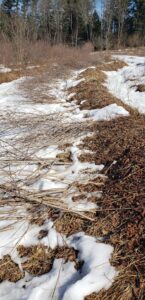
Pruning certain trees such as apples, stone fruit, and those in the prunus family is standard practice and can help manage the spread of disease, encourage new growth, and improve the quality of the fruit. However, it may not be as critical in an agroforestry planting. If you are growing these fruits, it is unlikely that you will produce them on a scale necessary for the commercial fresh-eating market. The exception to this might be cider apples (although the beauty of cider is that no one ever sees the apples that go into it!). A chestnut tree may need an occasional limb removed to prevent further wind damage, but otherwise, many trees and shrubs will be productive enough without intensive annual pruning. This is all the more true if the fruits of your trees are intended to feed livestock or wildlife, where the primary function of the trees is to provide shade or windbreaks in your field.
Coppicing, or removing the aerial portions of a tree or shrub down to a stem that is 4-6” tall while dormant, is done to invigorate new growth and can be highly advantageous for managing and maintaining productivity in hazelnuts, elderberry, willows, and several other species for decades or even centuries. Pollarding is the practice of cutting back the upper branches of a tree while dormant to create vigorous bushy growth above browse height. This growth is then harvested by hand and fed to livestock, typically during a dry spell when other forage options on the ground are limited.

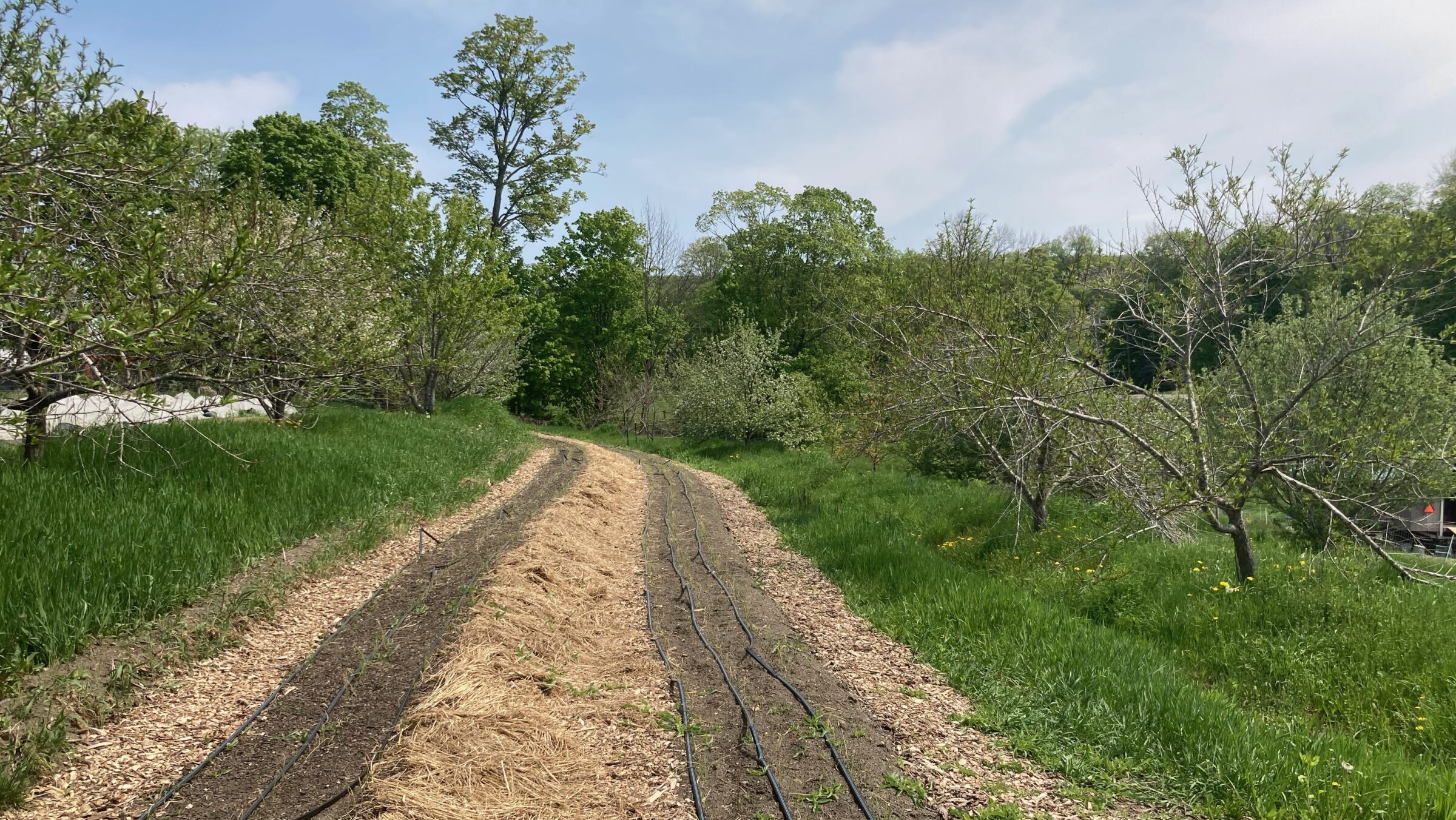
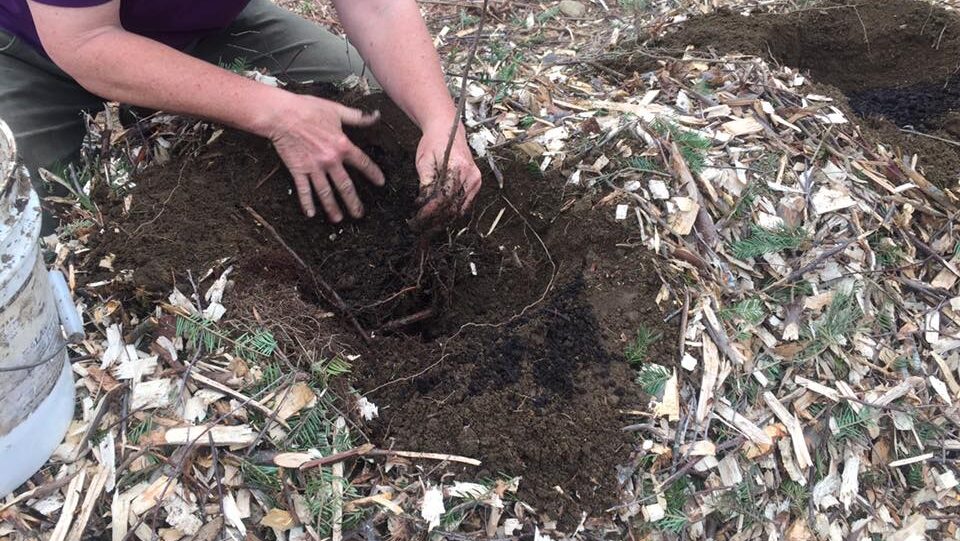
Comments (0)